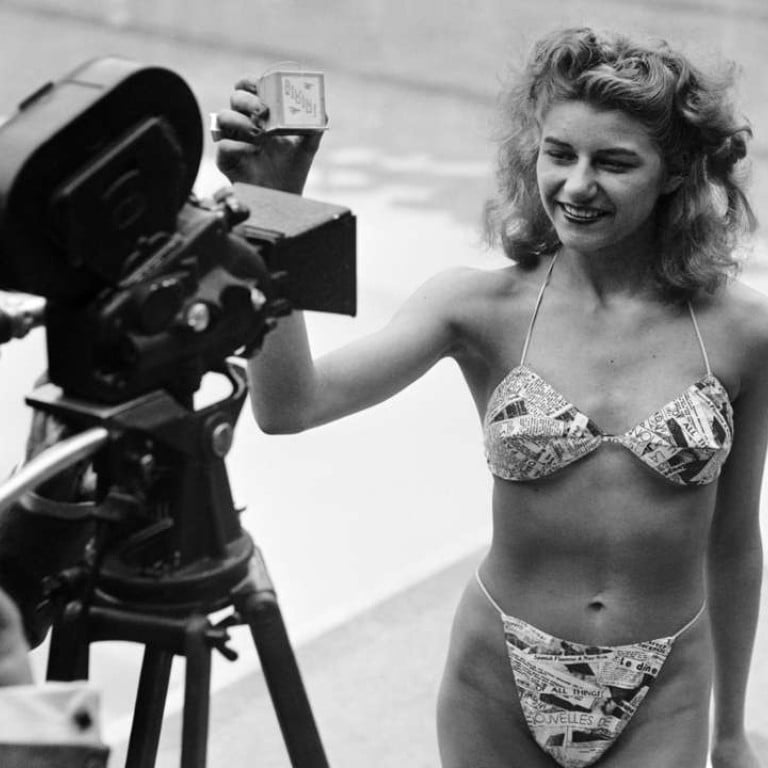
70 years of the bikini, the women who made it hot and the Hong Kong designers celebrating
As the famous two-piece swimsuit reaches a milestone, we look at its history and talk with two fashion designers about how it helped them make it big
Erin Deering and Craig Ellis have many reasons to celebrate the birthday of the bikini, which this month (July) turns 70. In fact they have 45 million reasons if you’re counting in US dollars.
That’s the amount Triangl – the bikini brand the couple founded in 2012 – reported in sales last year.
It’s been a quick ascent for the couple from Melbourne, Australia, who spotted a niche in the market for a sporty-looking, well-constructed yet affordable bikini when Deering could not find a perfect bikini in her price range.

“That same day we were inspired by the idea of starting a designer swimwear label that was more affordable and accessible, so it pretty much started from there.”
The duo quit their jobs, sold their possessions and moved from Australia to Hong Kong to be closer to the supply chain. But money was tight, and they were reduced to packing orders from their tiny flat in Central.
“We moved to Hong Kong to focus 100 per cent on the business. It was a relatively easy move because Hong Kong’s very central from a global logistics point of view. We wanted to ensure that our products reached our customers quickly!
“We were down to our last few hundred dollars,” says Deering, who worked in e-retail. Ellis is a former Australian rules football player.
“We swallowed our pride and asked some friends to lend us a small amount of money to get our first production of Triangl under way. I guess the rest is history.”
Today the brand continues to take the swimwear industry by storm. And it’s all been achieved without spending a cent on advertising, instead relying on photo-sharing platforms for exposure (Triangl’s Instagram account has three million followers).

“Girls who wear our bikinis genuinely love the brand. As we had close to zero marketing budget in the beginning we had to be more creative and think of cost effective ways to market our product – so social media was where we headed.
“Instagram has been pivotal to our success – we love how we can directly communicate with our customers. It’s been crucial to the growth of our brand and is something we really value.”
Hong Kong-based fashion designer Marie France Van Damme also has good reason to toast the bikini’s birthday – and the power of celebrity.

“Sales went through the roof,” says Canadian-born Van Damme, who moved to Hong Kong in the 1980s to start her manufacturing company specialising in women’s wear. She has a stand-alone store in Central’s IFC.
Van Damme says she sells about 10 bikinis for every one one-piece swimsuit, but admits a bikini “is the hardest thing I have ever designed”.
“It’s more popular than a one-piece swimsuit but I realised that if the top fits nicely then the bottoms often fit terribly.
“I stared at many ladies’ bottoms during a Phuket vacation, came home, and worked with my pattern maker to make the perfect triangle bikini,” she says.
“The fit of my first bikini was not good. Nor was the second, or third ... I have never spent so many hours fitting, correcting, pinning ... that small piece of clothing has been the most difficult garment to produce!”
The designer says there’s nothing worse than seeing a woman at the beach looking uncomfortable in her bikini, the bottom being too small or the top needing to be readjusted.
A staple of summer holidays, the bikini made its public debut in 1946 when 19-year-old nude dancer Micheline Bernardini modelled it while holding a matchbox in 1946. The press and public were shocked – it was the first time a wearer’s navel had been revealed.
Since then it has come to mean different things to different people.


For Van Damme the bikini symbolises freedom and girl power.
“This two-piece bathing suit created a lot of controversy in the puritanical 1950s. Many people found it scandalous for a woman to wear a bikini . Finally it became accepted in ‘Western society’. It’s about women’s emancipation, La liberte de la femme!

Other celebrated roles in popular culture include a catchy 1960 Brian Hyland song, Itsy Bitsy Teenie Weenie Yellow Polka Dot Bikini.

The bikini became a Hollywood prop with stars Rita Hayworth, Ava Gardner, Ester Williams and Marilyn Monroe wearing one, prompting Margit Fellegi for Cole of California and Catalina to mass manufacture bikinis complete with deep-cut necklines and bare midriffs, so audiences could copy their idols.
“In the 1960s the bikini became standard beachwear and was associated with California and San Tropez.”

Peirson-Smith says the bikini has played a significant social and cultural role as a mirror of body consciousness, moral concerns and sexual attitudes, its daring, revelatory design challenging moral codes. It took the minimally clothed female body into the public gaze both as a site of power and a spectacle to be looked at and judged.

